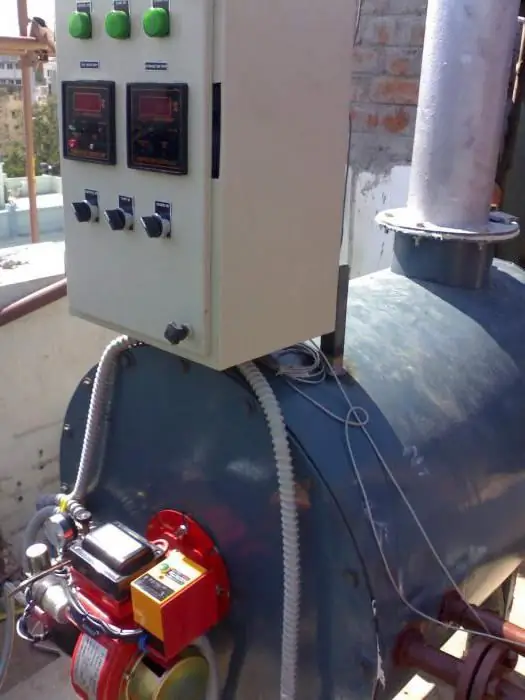2026 Author: Howard Calhoun | [email protected]. Last modified: 2025-06-01 07:12:56
Equipment for the generation of thermal energy has been used by man for several centuries. During this time, the design of the units has changed, allowing the owners to receive ever higher performance. Nowadays, this segment of industrial equipment is represented by a variety of options that differ in size, performance, type of fuel used and other parameters. In the new generation, industrial boilers are also equipped with automatic control systems with functional relays and control panels. Such additions help to improve the ergonomics and reliability of the units.
Features of industrial boilers

Unlike household models, industrial equipment is designed to service productive facilities that require high thermal power. Manufacturers of boilers are guided by this task. Usually these are massive structures, which are a complex multi-component system of mechanisms and communications. In classic units, devices are used that provide the production of steam or hot water. In the traditional set of elements,which industrial boilers have, includes combustion chambers, smoke exhausters, water treatment and feed plants, as well as protective devices. As performance requirements increase, this list expands with new operational infrastructure components.
What are the functions of industrial boilers?

A traditional unit of this type is used to generate steam, which is later used as a medium for driving engines. In particular, such tasks are performed in the power units of steam locomotives and turbines of power plants. For modern industry, steam production is less relevant, and the function of supplying thermal energy comes to the fore. A kind of technical heat is required for the needs of various industries, including textile production and agriculture. In public services, industrial heating boilers are also used, which also provide hot water preparation. Depending on the operating conditions and requirements for equipment, a boiler with certain properties and capabilities is selected. To understand the differences between the variations of such aggregates, you should familiarize yourself with their classification.
Equipment classifications
There are two approaches to the separation of industrial boilers - based on the types of coolant and the fuel used. As for the first sign, water is most often used as a working medium, although steam also does not lose its relevance. Less commonly used mercury, various antifreezes andother mixtures that mainly perform the functions of technological support for target objects. The design features that industrial boilers have are more clearly manifested in the classification of units according to the type of fuel used. In this case, equipment operating on solid-state resources, gas mixtures, electricity, etc. is highlighted.

Steam units
Representatives of this category, as the name implies, are designed to generate steam. Industrial-type units produce it for the needs of technical support. In particular, such equipment is used in woodworking enterprises. Steam exposure allows you to maintain optimal humidity parameters in the drying chambers. In medicine, industrial steam boilers are used to sterilize overalls and work equipment, while agriculture uses them in the manufacture of fertilizers and animal feed. It is important to separate saturated and superheated steam. In the industries listed above, just a saturated coolant is used. Superheated steam, in turn, finds application in special turbines of power plants. Therefore, boilers of this type are also called energy boilers. Often, units that produce superheated steam are used in a single complex with generators of saturated thermal media. This nuance allows us to classify power plants as industrial boilers.
Water boilers

This is one of the most extensive categories of industrial boilers. Hot watermodels are used to prepare working environments under high pressure. Boiling water in the equipment is not allowed, and the pressure indicators at all points do not exceed the threshold values for creating conditions for saturation of the coolant. Water heating installations are mainly used for the purpose of heat supply. In particular, they are used in public utilities to service district boiler houses. Industrial hot water boilers are also common, designed to provide the function of thermal power plants. These are the so-called peak units, the functions of which are reduced to the release of additional heat. At the same time, boilers of this type are also divided into water and gas pipe models. Water-tube installations have a screen heating surface, which includes heating elements containing a liquid heat carrier. The heat exchange process is implemented by heating the tubes with combustion products. Gas-tube models also contain small pipes on the heating working surface, but combustion products are used directly as a heat carrier.
Gas boilers
Utility equipment running on gas fuel is traditionally considered the most economical in terms of operating costs. In addition, the full cycle of combustion products processing is also reflected in the minimum emission of harmful particles into the atmosphere. Also, the advantages of such boilers include a high heating rate, which allows you to serve large areas without delay. Not yet throughout the country, but in general, there is a trend of stable gas supply, thereforethe relevance of such equipment is also growing. But industrial gas boilers also have serious drawbacks. The main one is safety. Still, the operation of gas in the form of a fuel component and partly a coolant theoretically poses a threat of explosion. Understanding this nuance, manufacturers seek to minimize such risks as much as possible. For such purposes, automatic control systems for boilers are being improved, and their bodies are made of high-strength modern materials.

Solid fuel equipment
Such boilers use wood, peat, pellets, coal, etc. as a fuel resource. The design of the unit provides for an ash pan, into which processed products are sent as the fuel burns. The need for constant maintenance of equipment with cleaning and cleaning of ash pans and loading of solid fuel components is one of the main disadvantages of such models. However, it is industrial units that are not so problematic in this sense, since they are equipped with automatic mechanisms for performing maintenance tasks. In addition, industrial solid fuel boilers are autonomous. While most analogues require connection to the main utilities, such a unit is completely independent and requires only timely delivery of fuel. The duration of work with the release of thermal energy is short, which limits the scope of the solid fuel boiler.

Universal boilers
The concept of universal equipment today is most fully revealed on the example of solid fuel and bio-boilers. The relevance of models capable of operating on several types of fuel is due to the desire of manufacturers to popularize biofuels. Not all consumers are ready to switch to fuel pellets, so the developers, almost as an option, supply classic industrial boilers with chambers for working with the same pellets. The result is hybrid designs that are multifunctional and cost-effective.
Examination of industrial boilers
It has already been noted that gas boilers are considered the most dangerous equipment in their class, but the operation of other types of units also involves certain risks. To prevent undesirable situations at the enterprises, special examinations are carried out, the purpose of which is to check the condition of the equipment and the quality of compliance with maintenance standards. An examination of the industrial safety of boilers is carried out in the following cases:
- After the assigned resource of the unit has been exhausted.
- After recovering from the aftermath of an accident.
- After repair operations or equipment upgrades.
Also, the need for an examination may be caused by doubts about the quality of the implementation of the operating rules. Especially if there were violations of the instructions or defects in the boiler itself.
Producers
The segment is wide enough and you can find a suitable one for almost any taskoption. For example, reliable and durable hot water boilers with a capacity of 1000-5000 kW are produced under the Byworth brand. The line includes models for both solid fuel and diesel. If high industrial safety of boilers is required, then it makes sense to turn to De Dietrich Thermique products. The company produces a family of reliable cast iron combined units that can be used in the maintenance of utilities and manufacturing enterprises. For smaller tasks, it is worth considering Turkish models of Erensan hot water boilers. Units are suitable for both gas fuel and liquid supply.

Conclusion
In addition to the principle of operation and design, boiler equipment also differs in performance. The capacity of the furnace, the generated power, as well as the volume of thermal energy are no less important parameters characterizing the operation of the unit. Recently, the importance of safety issues for such equipment has also increased. Regular industrial examination of boilers allows you to timely identify equipment malfunctions, as well as deviations from the standards for its maintenance. However, the manufacturers themselves are improving the safety of their products in different directions. Suffice it to mention the improvement of boiler control and management systems, additional strengthening of shells and increased maintenance requirements.
Recommended:
Management structure: types, types and functions

What is management? To answer this question, you need to dig deep into history. Sometimes this is not necessary for an ordinary person, but for those who work in this area, it seems to be mandatory. We believe that every person should know about everything, and therefore today we are talking about the management structure
Types of packages. Packaging of goods, its functions, types and characteristics

Each of us knows what packaging is. But not everyone understands that it serves not only to give a presentation to the product and make it more comfortable to transport. Some types of packaging are needed solely to protect the product from mechanical damage. Others - to give an attractive appearance, etc. Let's look into this issue and consider not only the main types, but also the functions of the packages
Insurance: essence, functions, forms, concept of insurance and types of insurance. The concept and types of social insurance

Today, insurance plays an important role in all spheres of life of citizens. The concept, essence, types of such relations are diverse, since the conditions and content of the contract directly depend on its object and parties
Industrial transport - functions, types and features

At the current stage of industrial development, logistics is of great importance. The speed of movement of various kinds of goods in the maintenance of production processes must be maintained at specified rates, otherwise enterprises will not be able to perform planned tasks. A key role in such processes is played by industrial transport, which carries out transportation, as well as performs lifting and unloading and other auxiliary functions
Industrial gas boilers: production, device, service life

The article is devoted to industrial gas boilers. The features of their design, types, nuances of maintenance, manufacturers, etc. are considered

